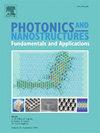Tunable NIR nano-absorber based on photothermal response and thermoplasmonic modulation of Au@GSST core-shell nanoparticle
IF 2.5
3区 物理与天体物理
Q3 MATERIALS SCIENCE, MULTIDISCIPLINARY
Photonics and Nanostructures-Fundamentals and Applications
Pub Date : 2025-02-20
DOI:10.1016/j.photonics.2025.101369
引用次数: 0
Abstract
Phase change materials (PCMs) are attractive candidates for tunable devices due to their unique properties, such as high degree of scalability, thermal control, low power consumption, wide waveband operation, and the ability to switch between different optical phases. These properties can be enhanced by integrating PCMs with other materials, such as plasmonic nanoparticles. In this work, a core-shell nanostructure (Au@GSST) is proposed comprising a gold nanoparticle (AuNP) core coated with Ge2Sb2Se4Te1 (GSST), a PCM with high optical contrast, embedded in an aqueous medium. We demonstrate how the phase transition of GSST can be actively controlled by the light energy absorption of the Au@GSST. The integration of the Au core facilitates the phase change process of GSST due to its plasmonic effect, which leads to lower heat capacity and higher heat conductivity of the AuNP. These characteristics accelerate the GSST phase change process at a lower continuous wave (CW) laser intensity compared to a bare GSST nanoparticle. An induced photothermal process that includes heat transfer, the crystalline fraction, and the electric field enhancement of the Au@GSST, as functions of the laser wavelength and intensity is investigated. Our results show that through this process, the GSST shell can be tuned between fully amorphous, intermediate, and fully crystalline states. This phase transition leads to a substantial modification of the optical responses of the Au@GSST. The absorption, scattering and extinction cross-sections of the structure over a wide range of wavelengths before and after the GSST phase transition is studied. We focus on two specific wavelengths, 778 nm and 919 nm, which exhibit higher light absorption contrast in both the amorphous and crystalline phases of GSST. Such active tunning of Au@GSST without morphological variation can be utilized in reconfigurable nanophotonic devices, such as switches, modulators, and sensors.
基于Au@GSST核壳纳米粒子光热响应和热等离子体调制的可调谐近红外纳米吸收剂
相变材料(PCMs)由于其独特的特性,如高度可扩展性,热控制,低功耗,宽波段操作以及在不同光学相位之间切换的能力,成为可调谐器件的有吸引力的候选者。这些特性可以通过将pcm与其他材料(如等离子体纳米粒子)集成来增强。在这项工作中,提出了一种核壳纳米结构(Au@GSST),该结构包括一个金纳米颗粒(AuNP)芯,表面涂有Ge2Sb2Se4Te1 (GSST),这是一种具有高光学对比度的PCM,嵌入在水介质中。我们演示了如何通过Au@GSST的光能吸收来主动控制GSST的相变。Au核的整合由于其等离子体效应促进了GSST的相变过程,使得AuNP的热容降低,导热系数提高。与裸GSST纳米颗粒相比,这些特性在较低的连续波(CW)激光强度下加速了GSST相变过程。研究了诱导光热过程,包括热传递、晶体分数和Au@GSST的电场增强,作为激光波长和强度的函数。我们的研究结果表明,通过这一过程,GSST壳可以在完全非晶、中间和完全结晶状态之间进行调谐。这种相变导致Au@GSST的光学响应发生了实质性的变化。研究了该结构在GSST相变前后宽波长范围内的吸收、散射和消光截面。我们重点研究了两个特定波长,778 nm和919 nm,这两个波长在GSST的非晶相和结晶相中都表现出更高的光吸收对比度。这种无形态变化的Au@GSST主动调谐可用于可重构的纳米光子器件,如开关、调制器和传感器。
本文章由计算机程序翻译,如有差异,请以英文原文为准。
求助全文
约1分钟内获得全文
求助全文
来源期刊
CiteScore
5.00
自引率
3.70%
发文量
77
审稿时长
62 days
期刊介绍:
This journal establishes a dedicated channel for physicists, material scientists, chemists, engineers and computer scientists who are interested in photonics and nanostructures, and especially in research related to photonic crystals, photonic band gaps and metamaterials. The Journal sheds light on the latest developments in this growing field of science that will see the emergence of faster telecommunications and ultimately computers that use light instead of electrons to connect components.

 求助内容:
求助内容: 应助结果提醒方式:
应助结果提醒方式:


